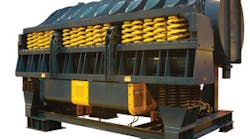Foundries expect a lot from shakeout systems: they want them to separate sand from castings, of course, and to reclaim sand for reuse and metal for recycling. They expect the machinery to be reliable, sturdy, and to require as little maintenance as possible. Designers of shakeout systems understand all this, but they know that more is expected, too.
For example, low overhead cost is critical. General Kinematics emphasizes that economy-minded plant operators will appreciate the effectiveness of its Vibra-Drum® Dross Reclamation Mill, a vibratory machine that “liberates” metal from slag and dross in either a continuous or batch process. It uses high-energy vibration to break down material up to five times faster than rotary or other types of reclamation devices, and the mill’s small footprint minimizes space requirements. Continuous removal of fines reduces the cushioning effect, increasing both capacity and grinding efficiency. In addition, the design is fully enclosed so it eliminates dust and other contaminants from escaping the process and fouling the plant environment.
For the specific task of separating sand from castings, General Kinematics recently introduced the Vibra-Claim™ series of shakeout/sand attrition mills, which it states will combine the performance of a direct-drive shakeout with its own Vibra-Mill® technology, for an “all-in-one shakeout and reclamation solution.”
The Vibra-Claim uses a solid shakeout deck to remove sand molds from the castings. Once the sand separates from the casting, it is conveyed forward into the attrition section of the machine so the casting can be removed.
Mounted on low-stress steel coil isolation springs to minimize the effects of vibration on the plant floor, Vibra-Claim has an “open tub” design that GK states will eliminate the maintenance and operational problems inherent in multiple deck units. Lumps are reduced to -20 mesh with original grain-size distribution and corresponding reduction in loss-on-ignition. With proper addition of new sand, the builder explains, reclaimed material is clean and ready for new mold production without further attrition.
The new machine series is powered by two self-contained motorized drives that create the vibrating action necessary to shakeout castings and to process sand lumps into original grain size. Motors are specially constructed for vibratory service, including a dust-tight, totally enclosed design. The drives are easy to access for service and maintenance.
Didion International introduced a new rotary shakeout system recently. The Mark 5 Series machine combines shakeout, sand conditioning, double sand screening, casting cleaning, and casting cooling, so the foundry accomplishes several objectives with a single investment, and achieves a cleaner work environment because of the decrease in airborne silica dust. Cleaned and cooled castings proceed to the finishing area, and the return sand is blended and conditioned for reuse. Didion’s customers have reported that its patented combination system has the world’s lowest operating cost, and can save a plant $40-$80/ton of castings.
Extending its pursuit of process effectiveness with its rotary equipment, Didion recounts the successful case of an iron foundry that installed its Didion® Rotary Separator/Metal Reclaimer with a variable jet burner, and a Conveyor Dynamics Feed Conveyor, to recover the metal fines from its waste stream. The installation was designed with a dust-tight Load Hopper, to be loaded with the detritus from the shakeout process by a front-end loader and metered into the Didion® Rotary Separator/Metal Reclaimer. For process efficiency, the new equipment was installed outside the plant (to diminish fugitive particulates inside the plant) but near to the charging/melting operation. Since it was installed, the un-manned, stand-alone system has reclaimed more than 1,500 tons of reusable metal that otherwise would have been landfilled, which would have resulted in an expense rather than the cost savings that resulted.
“When we started accumulating the metal fines waste stream four years ago we couldn’t even give it away for free, much less sell it,” according to the foundry’s staff environmental engineer. “With the addition of the Metal Reclaim System we will continue to recover 1% of metal for every ton of metal melted, permanently increasing our utilization of scrap while taking another step in reaching our company goal of net-zero waste.”











